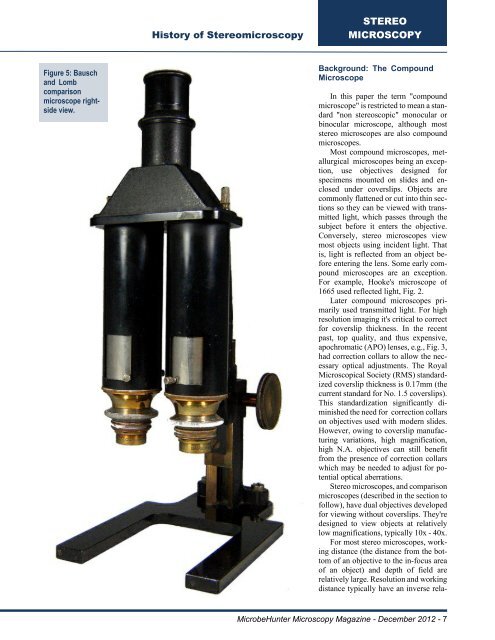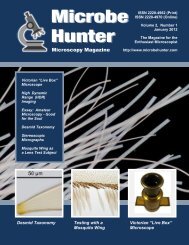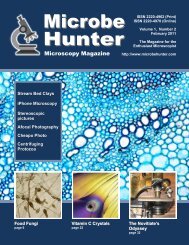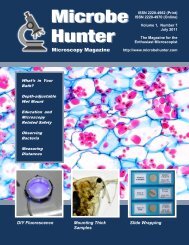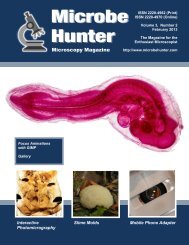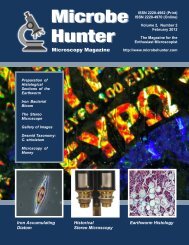December 2012 - MicrobeHunter.com
December 2012 - MicrobeHunter.com
December 2012 - MicrobeHunter.com
Create successful ePaper yourself
Turn your PDF publications into a flip-book with our unique Google optimized e-Paper software.
History of StereomicroscopySTEREOMICROSCOPYFigure 5: Bauschand Lomb<strong>com</strong>parisonmicroscope rightsideview.Background: The CompoundMicroscopeIn this paper the term "<strong>com</strong>poundmicroscope" is restricted to mean a standard"non stereoscopic" monocular orbinocular microscope, although moststereo microscopes are also <strong>com</strong>poundmicroscopes.Most <strong>com</strong>pound microscopes, metallurgicalmicroscopes being an exception,use objectives designed forspecimens mounted on slides and enclosedunder coverslips. Objects are<strong>com</strong>monly flattened or cut into thin sectionsso they can be viewed with transmittedlight, which passes through thesubject before it enters the objective.Conversely, stereo microscopes viewmost objects using incident light. Thatis, light is reflected from an object beforeentering the lens. Some early <strong>com</strong>poundmicroscopes are an exception.For example, Hooke's microscope of1665 used reflected light, Fig. 2.Later <strong>com</strong>pound microscopes primarilyused transmitted light. For highresolution imaging it's critical to correctfor coverslip thickness. In the recentpast, top quality, and thus expensive,apochromatic (APO) lenses, e.g., Fig. 3,had correction collars to allow the necessaryoptical adjustments. The RoyalMicroscopical Society (RMS) standardizedcoverslip thickness is 0.17mm (thecurrent standard for No. 1.5 coverslips).This standardization significantly diminishedthe need for correction collarson objectives used with modern slides.However, owing to coverslip manufacturingvariations, high magnification,high N.A. objectives can still benefitfrom the presence of correction collarswhich may be needed to adjust for potentialoptical aberrations.Stereo microscopes, and <strong>com</strong>parisonmicroscopes (described in the section tofollow), have dual objectives developedfor viewing without coverslips. They'redesigned to view objects at relativelylow magnifications, typically 10x - 40x.For most stereo microscopes, workingdistance (the distance from the bottomof an objective to the in-focus areaof an object) and depth of field arerelatively large. Resolution and workingdistance typically have an inverse rela-<strong>MicrobeHunter</strong> Microscopy Magazine - <strong>December</strong> <strong>2012</strong> - 7


